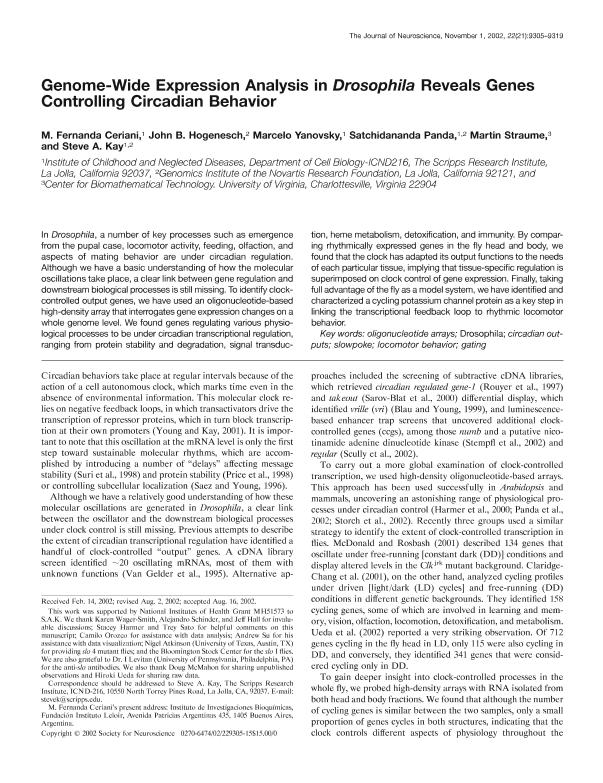Artículo
Genome-Wide Expression Analysis in Drosophila Reveals Genes Controlling Circadian Behavior
Ceriani, Maria Fernanda ; Hogenesch, John B.; Yanovsky, Marcelo Javier
; Hogenesch, John B.; Yanovsky, Marcelo Javier ; Panda, Satchidananda; Straume, Martin; Kay, Steve A.
; Panda, Satchidananda; Straume, Martin; Kay, Steve A.
 ; Hogenesch, John B.; Yanovsky, Marcelo Javier
; Hogenesch, John B.; Yanovsky, Marcelo Javier ; Panda, Satchidananda; Straume, Martin; Kay, Steve A.
; Panda, Satchidananda; Straume, Martin; Kay, Steve A.
Fecha de publicación:
11/2002
Editorial:
Society for Neuroscience
Revista:
Journal of Neuroscience
ISSN:
0270-6474
e-ISSN:
1529-2401
Idioma:
Inglés
Tipo de recurso:
Artículo publicado
Clasificación temática:
Resumen
In Drosophila, a number of key processes such as emergence from the pupal case, locomotor activity, feeding, olfaction, and aspects of mating behavior are under circadian regulation. Although we have a basic understanding of how the molecular oscillations take place, a clear link between gene regulation and downstream biological processes is still missing. To identify clock-controlled output genes, we have used an oligonucleotide-based high-density array that interrogates gene expression changes on a whole genome level. We found genes regulating various physiological processes to be under circadian transcriptional regulation, ranging from protein stability and degradation, signal transduction, heme metabolism, detoxification, and immunity. By comparing rhythmically expressed genes in the fly head and body, we found that the clock has adapted its output functions to the needs of each particular tissue, implying that tissue-specific regulation is superimposed on clock control of gene expression. Finally, taking full advantage of the fly as a model system, we have identified and characterized a cycling potassium channel protein as a key step in linking the transcriptional feedback loop to rhythmic locomotor behavior.
Palabras clave:
Genechip Affymetrix
,
Drosophila
,
Slowpoke
,
Arrthythmic Behavior
Archivos asociados
Licencia
Identificadores
Colecciones
Articulos(IIBBA)
Articulos de INST.DE INVEST.BIOQUIMICAS DE BS.AS(I)
Articulos de INST.DE INVEST.BIOQUIMICAS DE BS.AS(I)
Citación
Ceriani, Maria Fernanda; Hogenesch, John B.; Yanovsky, Marcelo Javier; Panda, Satchidananda; Straume, Martin; et al.; Genome-Wide Expression Analysis in Drosophila Reveals Genes Controlling Circadian Behavior; Society for Neuroscience; Journal of Neuroscience; 22; 21; 11-2002; 9305-9319
Compartir
Altmétricas



